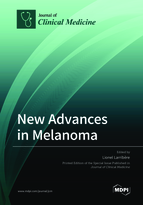New Advances in Melanoma
A special issue of Journal of Clinical Medicine (ISSN 2077-0383). This special issue belongs to the section "Dermatology".
Deadline for manuscript submissions: closed (20 December 2021) | Viewed by 22889
Special Issue Editor
2. Department of Dermatology, Venereology and Allergology, University Medical Center Mannheim, Ruprecht-Karl University of Heidelberg, 68167 Mannheim, Germany
Interests: malignant melanoma; drug resistance; biomarkers; translational oncology; reprogramming; neural crest development
Special Issue Information
Dear Colleagues,
Melanoma is a very aggressive tumor which derives from the transformation of pigment-producing cells—the melanocytes. This cancer type accounts for most of the deaths associated with skin cancer as well as its incidence, and is in constant evolution. Because of the rapid and very high metastatic potential of this tumor, melanoma prognosis has been quite poor for a long time. In the past decade, groundbreaking discoveries in the melanoma research field have led to the development of two main treatment strategies: combination therapies targeting specific kinases or combination therapies focused on immune checkpoint Inhibitors (ICIs). These treatment approaches have become the standard of care in most cancer centers and have significantly improved the prognosis and overall survival of advanced melanoma patients. Nevertheless, many patients do not benefit from or do not even respond to these treatments. It is therefore essential to better comprehend the phenomenon of drug resistance, immune escape mechanism, as well as to search for alternative treatment strategies. In addition, strong predictive biomarkers are desperately needed to improve clinical efficacy. The aim of this Special Issue is to present recent advances in the field of melanoma research. Investigations covering the above-cited areas will be our primary focus, however, other areas of interest to the theme are also welcome.
Dr. Lionel Larribère
Guest Editor
Manuscript Submission Information
Manuscripts should be submitted online at www.mdpi.com by registering and logging in to this website. Once you are registered, click here to go to the submission form. Manuscripts can be submitted until the deadline. All submissions that pass pre-check are peer-reviewed. Accepted papers will be published continuously in the journal (as soon as accepted) and will be listed together on the special issue website. Research articles, review articles as well as short communications are invited. For planned papers, a title and short abstract (about 100 words) can be sent to the Editorial Office for announcement on this website.
Submitted manuscripts should not have been published previously, nor be under consideration for publication elsewhere (except conference proceedings papers). All manuscripts are thoroughly refereed through a single-blind peer-review process. A guide for authors and other relevant information for submission of manuscripts is available on the Instructions for Authors page. Journal of Clinical Medicine is an international peer-reviewed open access semimonthly journal published by MDPI.
Please visit the Instructions for Authors page before submitting a manuscript. The Article Processing Charge (APC) for publication in this open access journal is 2600 CHF (Swiss Francs). Submitted papers should be well formatted and use good English. Authors may use MDPI's English editing service prior to publication or during author revisions.
Keywords
- melanoma
- drug resistance
- targeted therapy
- immunotherapy
- genetics
- epigenetics
- signaling pathways
- molecular mechanisms







